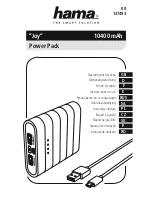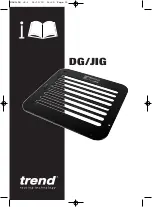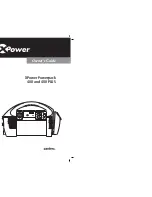
Power supply . . . . . . . . . . . . . . . . . . . . . . . . . . . . 230V ~ 8.6A
Power . . . . . . . . . . . . . . . . . . . . . . . . . . . . . . . . . . . . . . .2000W
temperature range . . . . . . . . . . . . . . . . . 50-450°C / 90-600°C
Air flow . . . . . . . . . . . . . . . . . . . . . . . . . . . . . . . .250-500ltr/min
Two step air flow control switch, with variable temperature range on both levels. The hot air gun is designed to stand vertically, allowing use as a
safe Bunsen burner alternative. Suitable for paint stripping, soft soldering, removing sticky labels and defrosting frozen pipes.
Fitted BS approved 3 pin safety plug. Supplied with four nozzles and scraper, all in a storage case.
4.1.
Preparing the hot air gun for use
4.1.1. Before plugging into the mains ensure the hot air gun switch is in the off ’0' position.
4.1.2. When ready to start work, set switch to the required temperature setting (fig.1) and air flow speed (fig.2). Allow one and a half minutes
to heat.
NOTE:
When new, the hot air gun may generate smoke which will decrease with use.
WARNING!
KEEP HANDS AWAY FROM THE IMMEDIATE NOZZLE AREA. IF LEAD PAINT IS BEING REMOVED FOLLOW THE
SAFETY WARNING AT THE BEGINNING OF THIS MANUAL. ALWAYS WEAR GLOVES AND EYE PROTEcTION.
4.2.
Paint and varnish removal
the easy removal of paint and varnish requires practice. Follow these simple working techniques to achieve the required result.
NOTE:
the hot air gun is designed to remove both oil and latex based paints and varnishes from surfaces. It will not remove stains
or primer coats that have impregnated the surface.
4.2.1. Switch the hot air gun on and allow it to reach its operating temperature.
4.2.2. Always test on a small non-critical area first.
4.2.3. Hold the gun nozzle 3” (75mm) to 4” (100mm) from the paint to be removed.
4.2.4. After a short time the paint will soften and begin to blister.
4.2.5.
DO NOT
overheat the paint as this will cause it to burn which makes it more difficult to remove.
Wear eye protection, especially
when stripping paint from overhead. If lead paint is being removed, refer to the warning at the beginning of this manual.
4.2.6. Begin scraping the paint off. Work from top to bottom. Use a scraper with smooth even strokes, warming the surface in front of the
scraper by moving the hot air gun slightly from side to side.
4.2.7. If the correct temperature has been applied to the paint, thick, even layers can be removed in a single pass (paint should be removed
in strips equal in width to the scraper blade). Scrape paint as soon as it becomes soft, as it will re-harden very quickly.
4.2.8. Keep the scraper blade edge clean and sharp to prevent paint peelings from building up.
4.2.9. After softening, shaped or profiled surfaces may be stripped by using a wire brush.
4.2.10. to protect surrounding surfaces from the heat, cover with a non-flammable material.
IMPORTANT: Do not concentrate the hot air gun on glass as the glass may crack.
fig.1
fig.2
DO NOT
use the hot air gun in rain or in a wet environment, or in areas of high humidity and damp (i.e. bathrooms, steam rooms, etc.).
DO NOT
obstruct the hot airflow by blocking or covering the air outlet.
DO NOT
touch the nozzle during, or after, use as it becomes extremely hot.
DO NOT
leave the hot air gun running unattended. Always turn off the power supply.
DO NOT
use the hot air gun on a task it is not designed for.
DO NOT
use the hot air gun in combination with chemical strippers.
DO NOT
operate the hot air gun when you are tired or under the influence of alcohol, drugs or intoxicating medication.
DANGER! DO NOT USE THE HOT AIR GUN AS A HAIR DRYER.
WARNING: The warnings, cautions and instructions discussed in this instruction manual cannot cover all possible conditions and
situations that may occur. It must be understood that common sense and caution are factors which cannot be built into this product,
but must be applied by the operator.
1.3.
LEAD PAINT WARNING!
Paint once contained lead as a traditional ingredient. Paint particles, resulting from the removal of such
paint, are toxic and ingestion/inhalation must, therefore, be avoided. the following action must be taken before using this tool:
1.3.1. the operator must determine potential hazard relating to age of paint to be removed (modern paints do not have lead content).
1.3.2.
DANGER!
Keep all persons and pets away from the work area. the following are particularly vulnerable to the effects of lead paint
dust:
Expectant women, babies and children.
1.3.3. We recommend personal protection by using the following safety items:
Paint Spray Respirator (Sealey ref. SSP1699), PE coated
Hooded coverall (Sealey ref. SSP267), Latex Gloves (Sealey ref. SSP24).
1.3.4. take adequate measures to contain the paint dust, flakes, and scrapings.
1.3.5. When task is complete continue to wear safety equipment as in 1.3.3. and thoroughly clean all areas. Ensure paint waste is disposed
of in sealed bags or containers.
2. INTRODUCTION
3. SPECIFICATION
4. OPERATION
HS107K Issue: 3(l) - 24/03/15
Original Language Version
© Jack Sealey limited





















